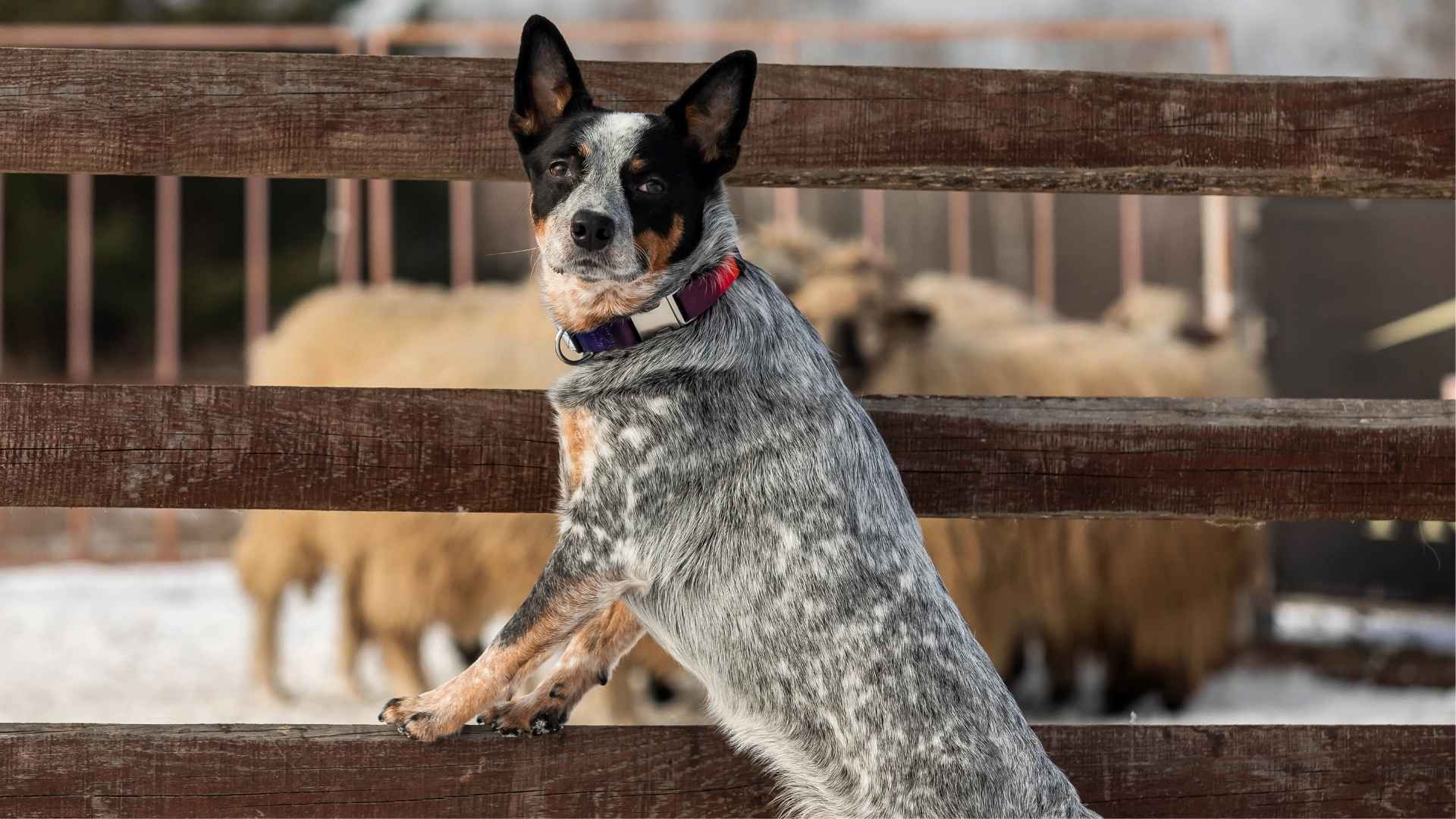When you think of herding breeds, you might picture a Border Collie darting across a field or a Corgi confidently nudging sheep along—cute, clever, and bursting with energy. But guess what? Not all herding dogs are full-speed ahead! Some breeds bring the brains and the chill.
Welcome to the world of easygoing herding dog breeds—the ones who herd with heart but also love a good cuddle on the couch. From the sheepdog who moonlights as a fluffy teddy bear to the heeler who knows when it’s time to nap, these pups prove that not all herders are go-go-go.
Whether you live in the city, the suburbs, or a quiet farmhouse, there’s a calm canine companion ready to fit right into your rhythm. So, if you’re looking for a dog who’s both smart and serene, read on—we’ve rounded up the best mellow herders that make paw-some family pets!
Easygoing Herding Dog Breeds
1. Australian Kelpie
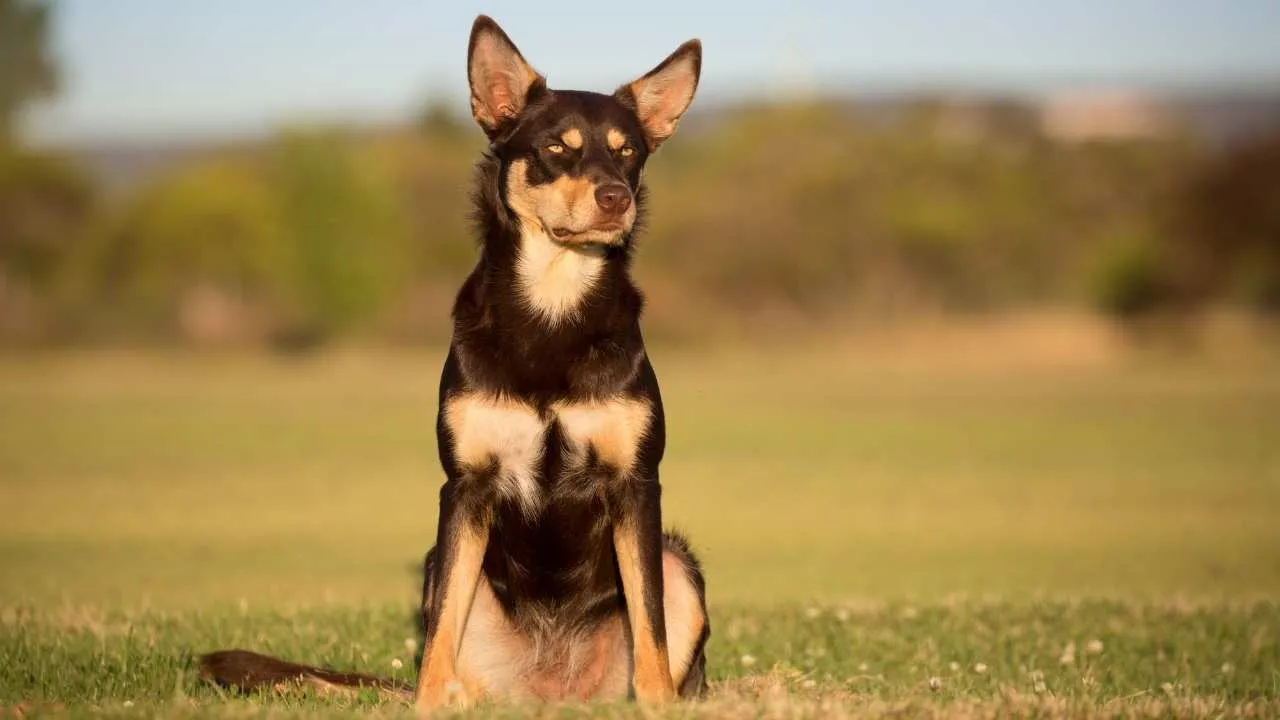
The Australian Kelpie is a dynamic, medium-sized herding dog breed hailing from the rugged outback of Australia. Built for action with a lean, athletic frame, this breed thrives on hard work and loves having a job to do. Whether managing sheep or rounding up cattle, Kelpies are in their element when they’re on the move.
What makes the Kelpie truly special is its unmatched intelligence and versatility. These dogs can cover vast and challenging terrain with ease and are capable of working independently—no micromanaging required!
Their sharp instincts and lightning-fast reflexes make them invaluable on farms, but they also shine in dog sports, agility training, and herding trials. Their eagerness to please and quick grasp of commands is what makes them highly trainable.
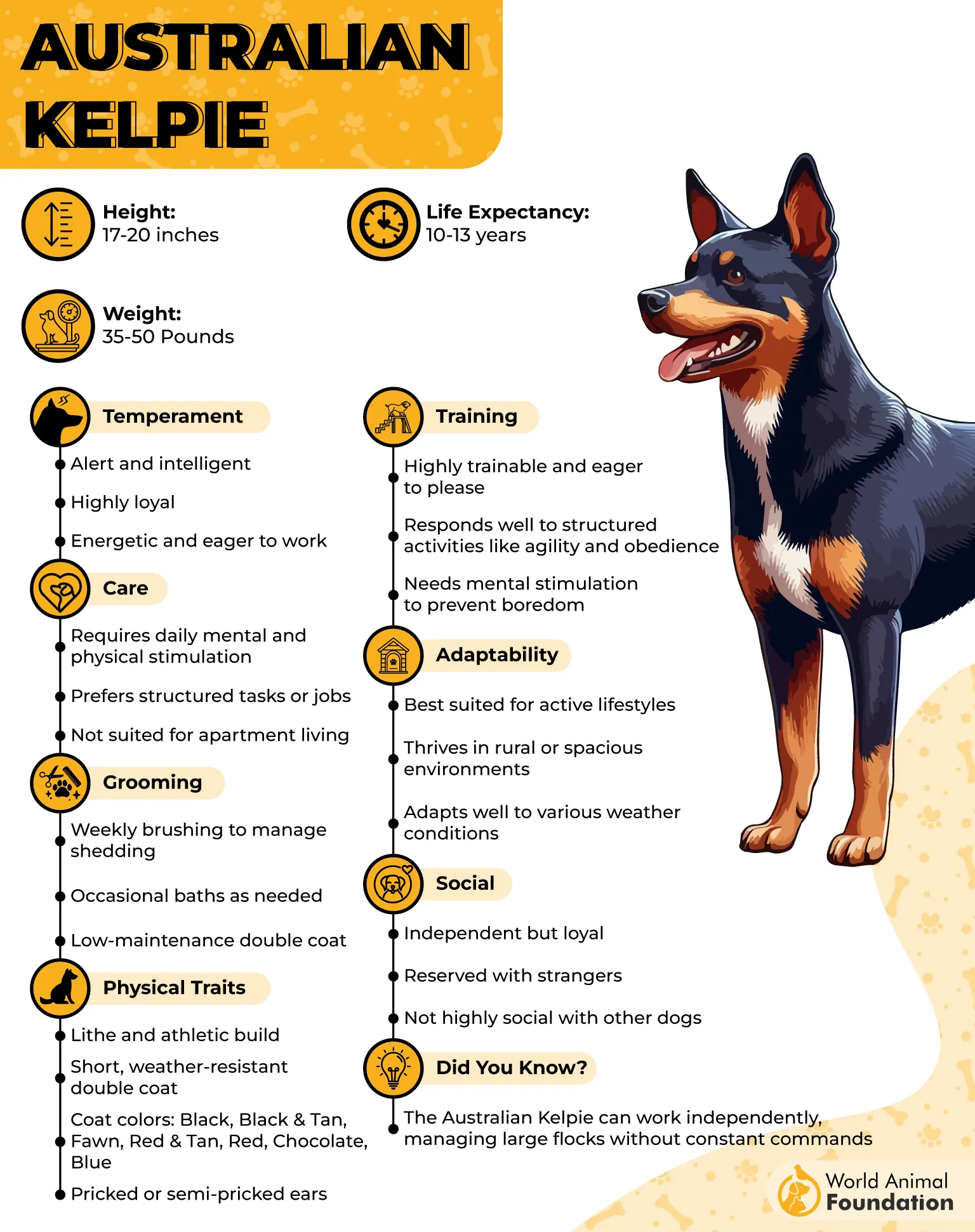
Kelpies are full of personality. They’re cheeky, clever, and known for their quirky sense of humor. These “velcro dogs” form strong bonds with their humans and want to be where the action is, whether that’s out on an adventure or curled up on the couch. They do tend to be reserved with strangers, making them excellent watchdogs, even if they’re not the confrontational type.
To keep a Kelpie happy, daily mental and physical stimulation is a must. Without it, boredom creeps in—and so does mischief. They thrive in active lifestyles with families or individuals who can match their energy and enthusiasm, and will find the Australian Kelpie to be a loyal, entertaining, and hard-working best friend.
2. Border Collie
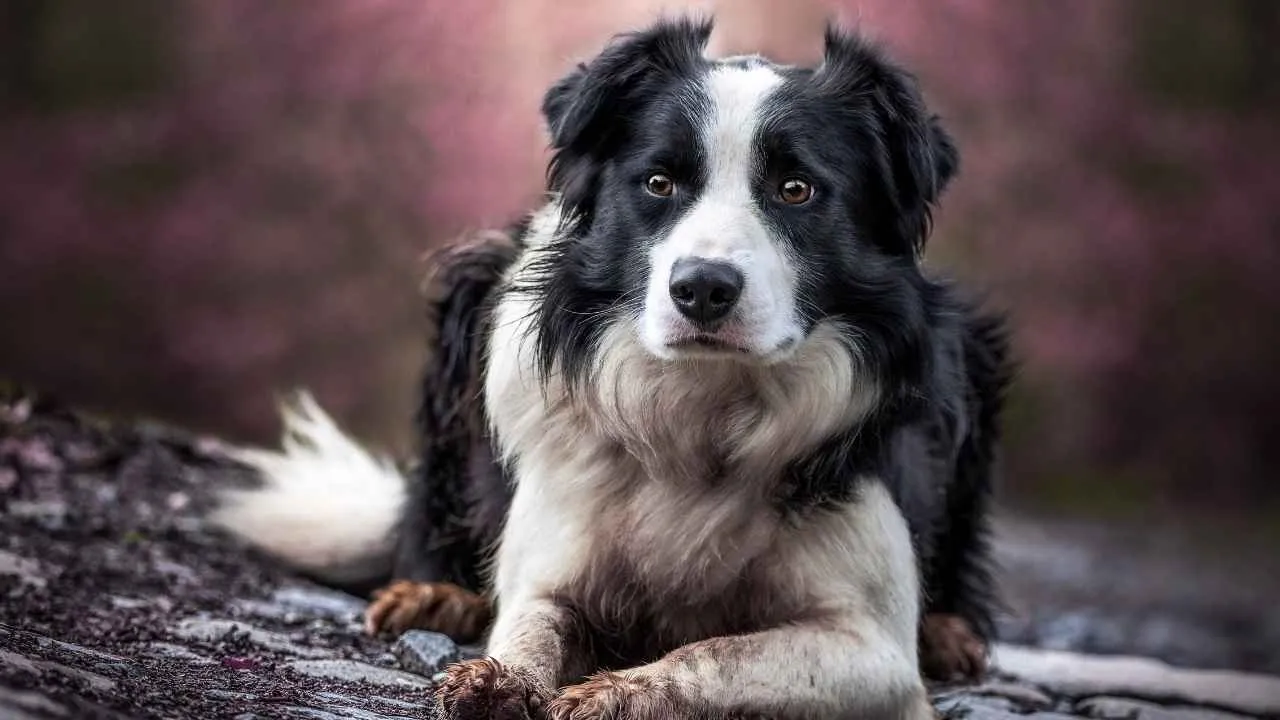
Border Collies come from the wild and windy borderlands of Scotland and England, where they earned their stripes as elite sheepdogs. With quick minds, boundless energy, and incredible agility, these pups were bred to handle tough jobs in tougher terrain. They’re not just herders—they’re thinkers, often figuring out what their humans want before a word is spoken.
At home, the Border Collie steps into the role of watchful guardian and loyal sidekick. Think of them as the family’s unofficial co-parent—they keep a close eye on everyone and love to be in the thick of it all. Whether it’s tag in the backyard or downtime on the couch, they’re happiest when included in the action.
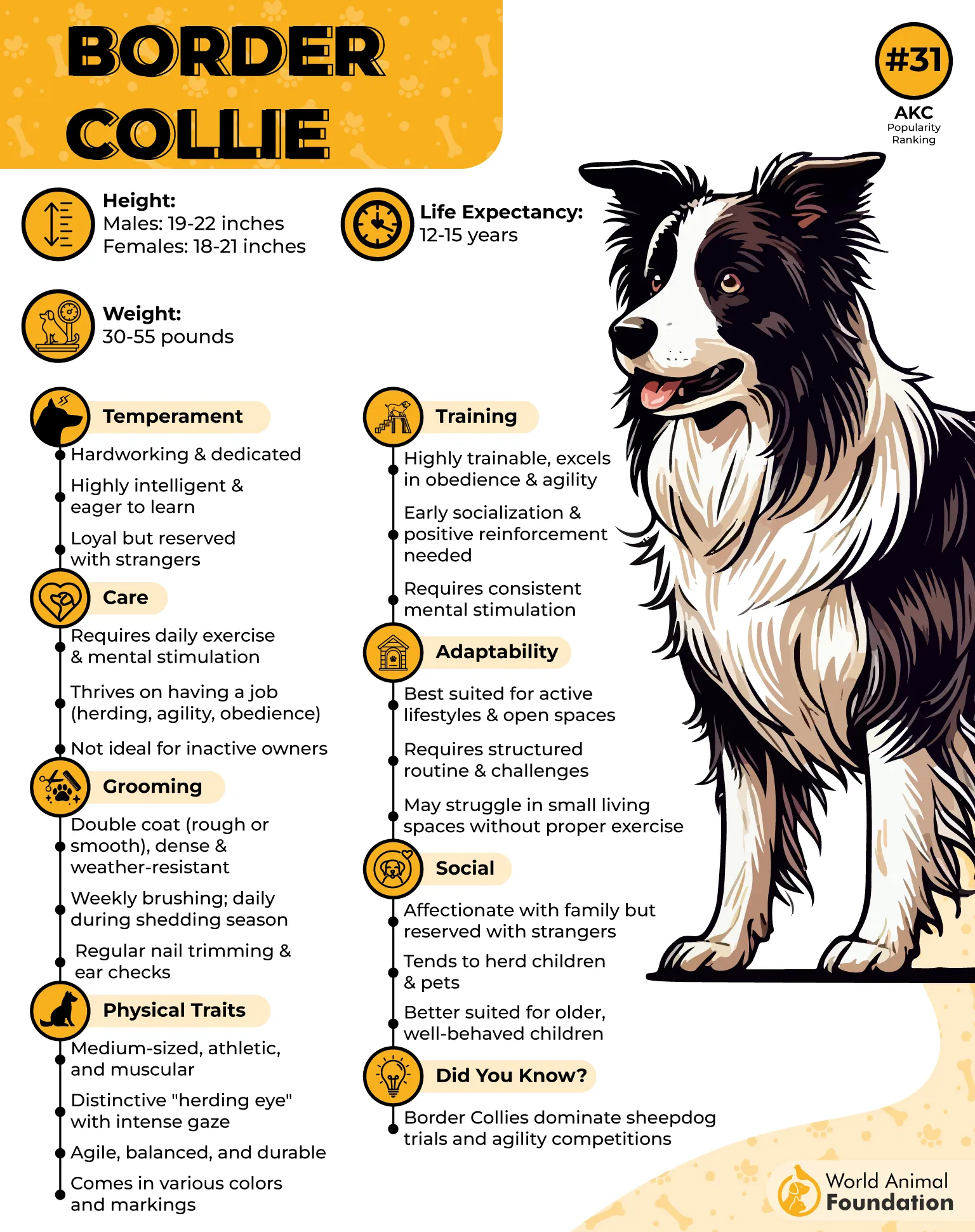
Known as one of the smartest breeds around, Border Collies thrive in dog sports like agility and obedience. Their coats, most commonly black and white (but also red, tricolor, or merle), need just a bit of brushing to stay fresh and fluff-free. Grooming is low-fuss—just a little trim here and there.
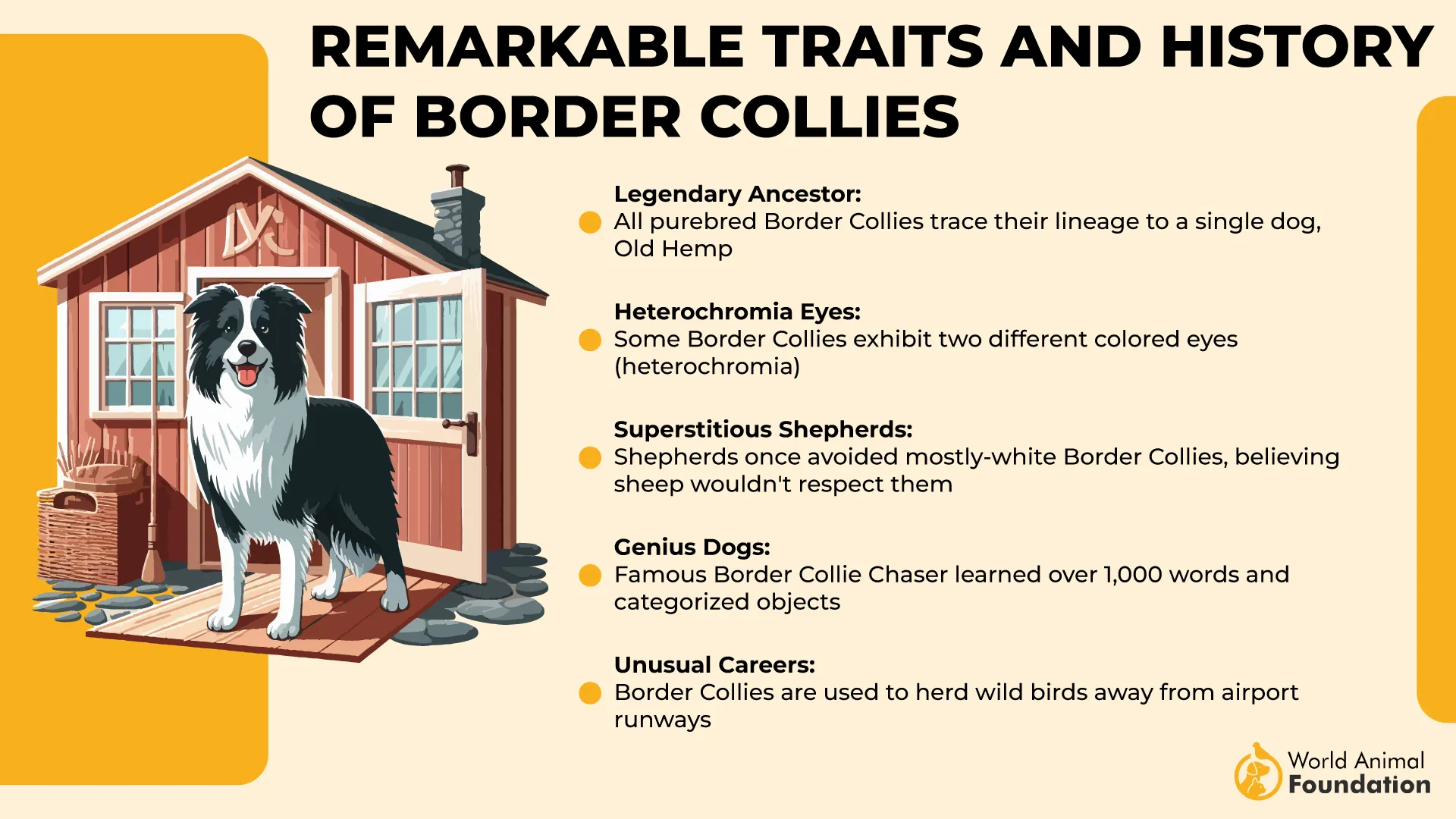
They’re big-time family dogs but can be a little shy with newcomers. Don’t expect fierce guard-dog vibes; they’re more likely to alert you with a bark than to act tough. That said, their keen senses make them excellent little watchdogs.
Now, fair warning- a bored Border Collie is a mischievous one. Without daily exercise and mental stimulation, things can get messy (chewed shoes, anyone?). But give them a job—chasing balls, learning tricks, or even “herding” your toddlers—and they’ll be the most joyful, loyal pup you’ve ever met.
3. Catahoula Leopard Dog
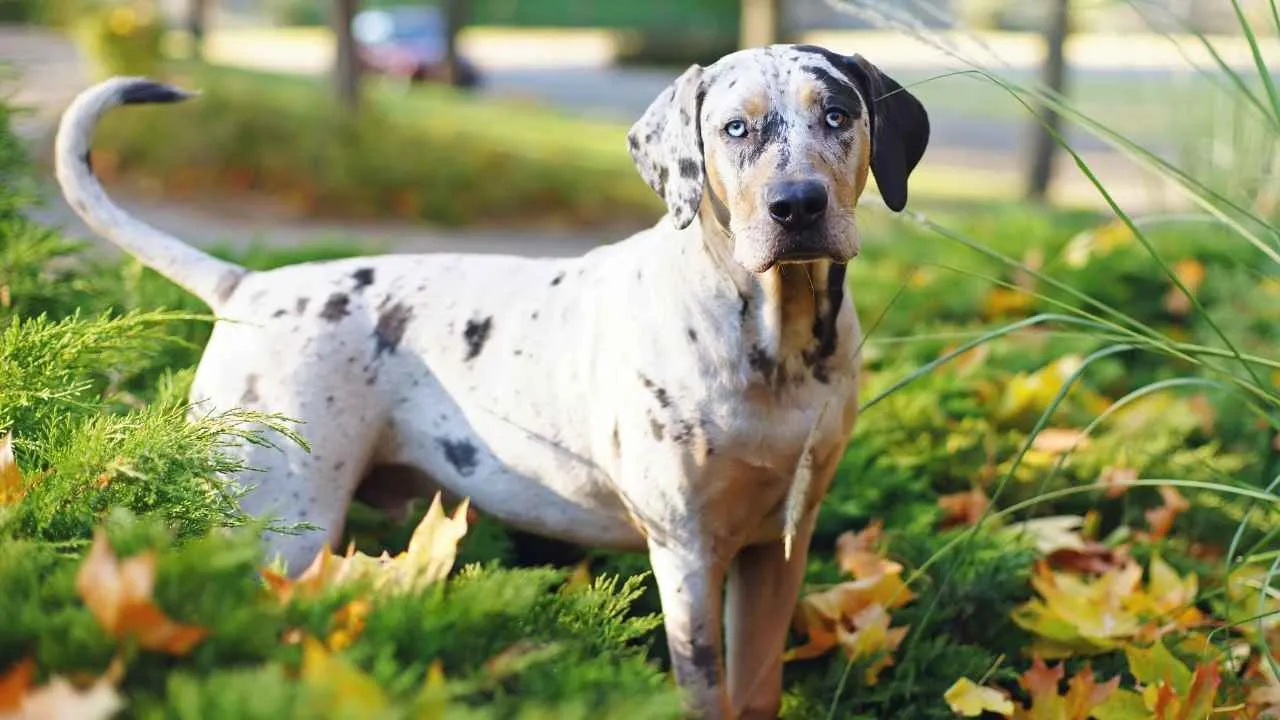
The Catahoula Leopard Dog, Louisiana’s pride and official state dog, is every bit as bold and beautiful as the bayous it comes from. Originally bred to herd livestock, protect flocks, and hunt wild hogs, this rugged Southern pup is strong, smart, and always ready for action. With their striking merle or brindle coats and piercing eyes, these powerful dogs are total head-turners.
Catahoulas are high-energy adventurers with a fiercely independent streak. They take their jobs seriously but love to unwind with their people. These dogs do best in homes with confident leadership, and socialization from younger age, states Hillspet.
Got a fenced yard? Perfect—because without regular activity, they’ll find creative outlets like digging or redecorating your shoes.
These dogs are incredibly loyal and make awesome watchdogs. They’re great with older kids and can live peacefully with other pets if raised together, but always supervise playtime. And while they love the outdoors, off-leash freedom should only happen in secure areas—because when natural instinct kicks in, they’ll be off like a rocket!
Training a Catahoula is all about patience and positivity. They’re smart and quick to learn, especially when there’s a task involved. Early training helps manage their natural protectiveness and ensures they play nicely with other pets and livestock. A well-socialized Catahoula is a confident, capable, and calm companion.
Grooming is a breeze—just a weekly brush and an occasional bath to keep their short coats looking sleek. Don’t forget the basics: trim those nails, clean the ears, and brush those teeth to keep them feeling their best.
4. Australian Cattle Dog
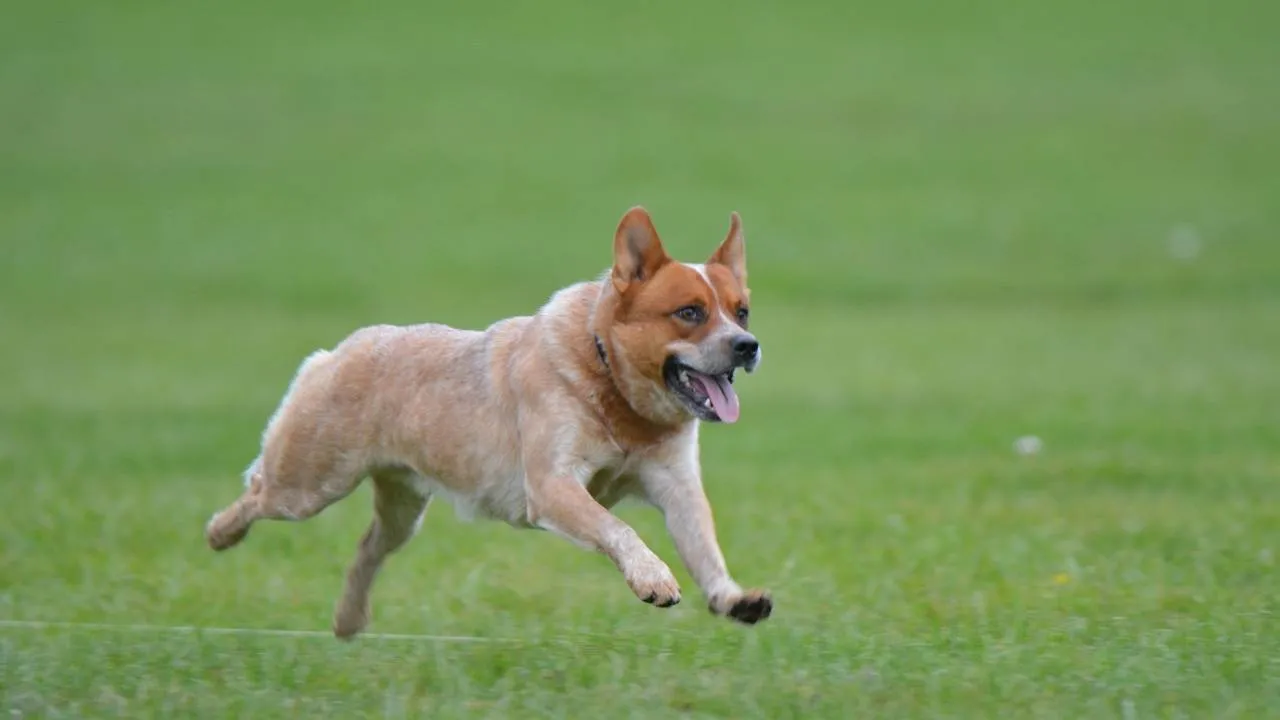
The Australian Cattle Dog, often called the Blue Heeler or Queensland Heeler, is pure Outback grit wrapped in a speckled coat. Bred in the 1800s to herd cattle through Australia’s toughest terrain, these tough cookies were crafted from herding dogs and wild dingos—resulting in a loyal, driven, and wildly intelligent breed and working companion.
Smart as a whip and fiercely independent, they love solving problems and figuring things out on their own. That’s why early socialization and consistent training are so important. These pups thrive on structure, positive reinforcement, and having a job—whether it’s agility sports, obedience, or just playing fetch with laser focus.
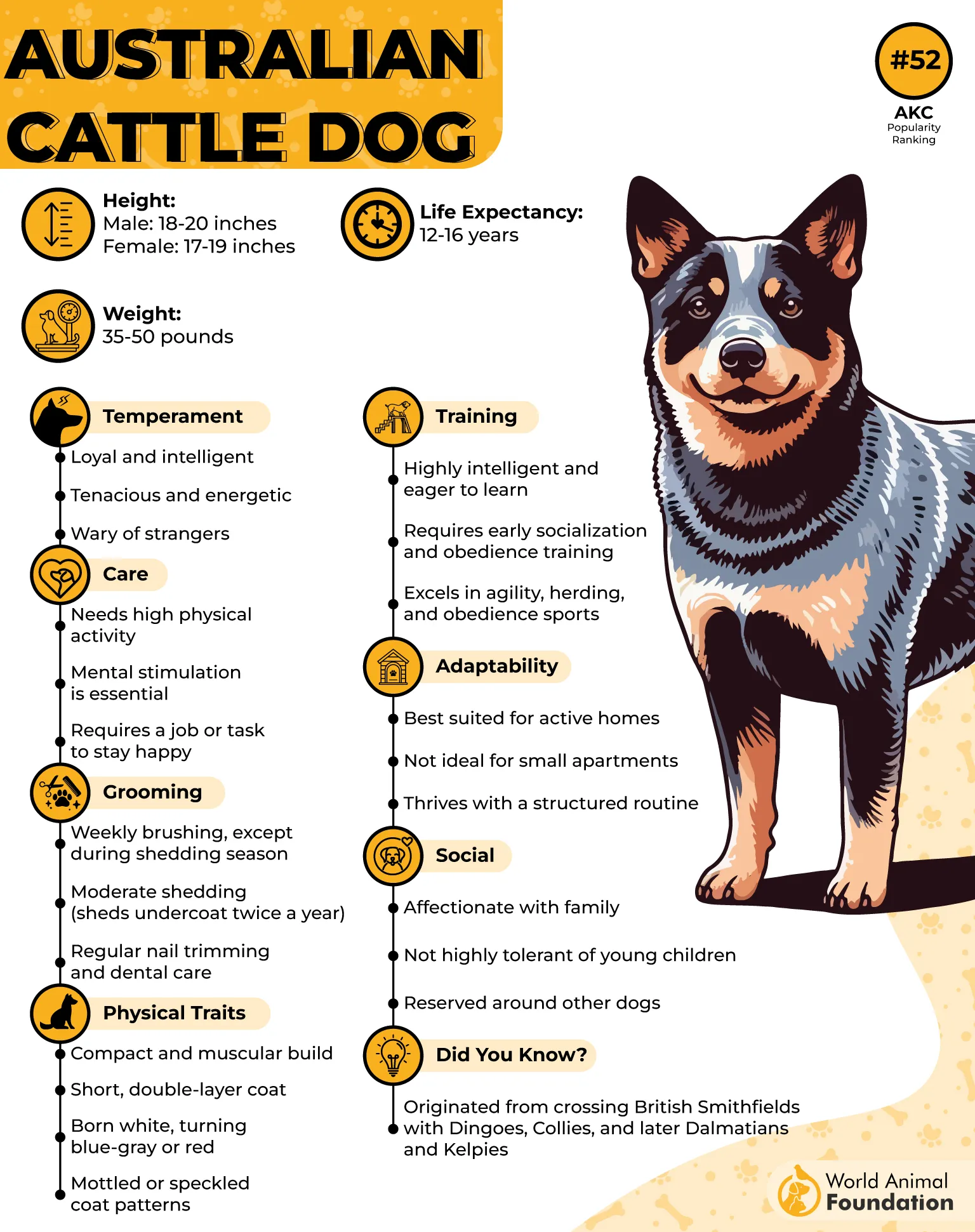
Aussie Cattle Dogs are go-go-go types. They need plenty of physical exercise and mental engagement, or they’ll find their own (not-so-adorable) ways to stay busy—like redecorating your furniture. Long walks, brain games, and active play keep them happy and balanced.
At home, they’re devoted and protective, often forming a deep bond with their favorite humans. With proper training and plenty of love, they make incredible companions—alert watchdogs, loyal sidekicks, and enthusiastic playmates for active families.
Fun Fact:
As noted by Britannica, Australian Cattle Dog puppies are born completely white! Their signature blue or red speckles and patches develop over the first few weeks as their pigmentation kicks in. It’s like watching a black-and-white photo come to life—just much fluffier.
5. Scotch Collie
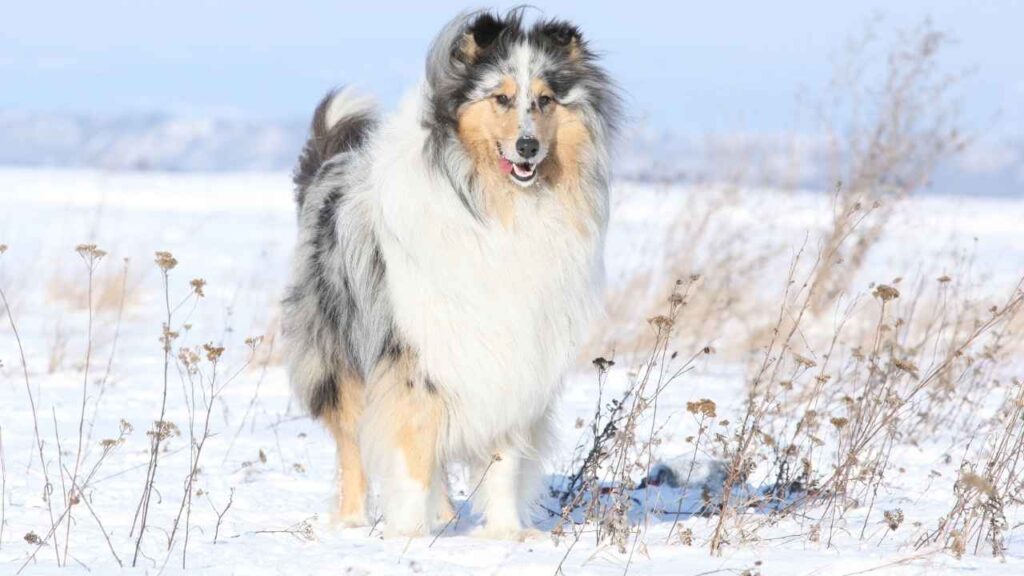
The Scotch Collie, also known as the “Old Farm Collie” or “Old-Time Scotch Collie,” is the original farmhand of the Scottish Highlands. Long before the polished Rough and Smooth Collies, this scrappy, multi-purpose farm dog herded sheep, guarded homes, and even helped with pest control in the barn—talk about a multitasker!
As a landrace breed, the Scotch Collie developed naturally over generations to suit the needs of hardworking farmers. So, while their looks can vary, you’ll always spot the hallmarks: strength, smarts, and agility.
Thanks to their herding roots, Scotch Collies are quick learners who genuinely enjoy pleasing their humans. They thrive on routine and mental challenges, so think daily walks, fetch sessions, and puzzle toys to keep that sharp mind buzzing.
In the family pack, Scotch Collies shine. They’re gentle with kids, affectionate with adults, and love being part of the action. Their herding instinct might show up during playtime, but a little training helps set boundaries. Whether you’ve got a backyard or just a love of the outdoors, this loyal sidekick is always ready for the next adventure.
6. Pembroke Welsh Corgi
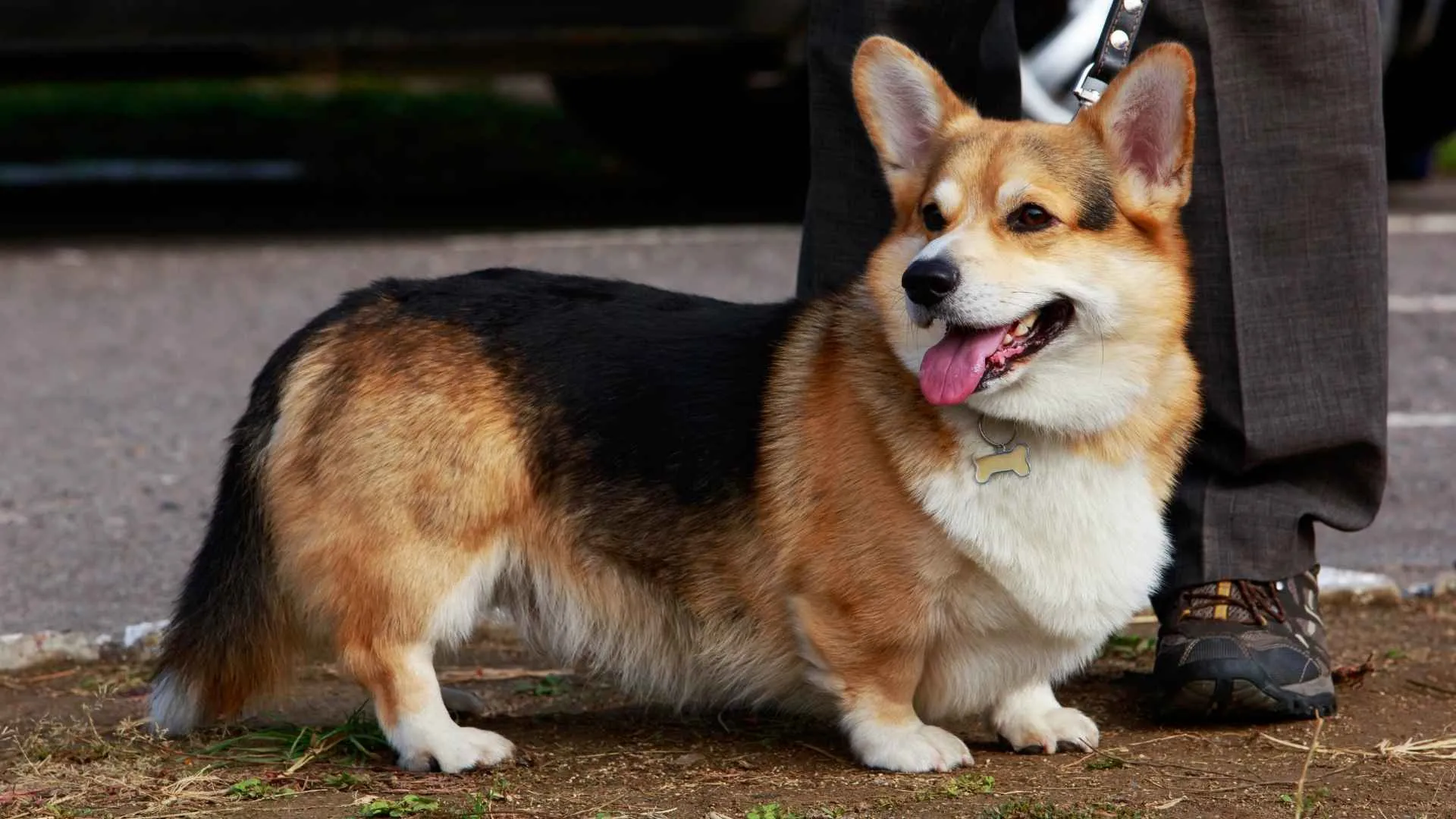
Say hello to the Pembroke Welsh Corgi — the little dog with a royal reputation and a personality that’s larger than life. With their signature short legs, upright ears, and “did-you-just-say-snacks?” expression, these herding pups were built for both work and charm.
Once wrangling cattle in the Welsh countryside, they’ve now stolen hearts worldwide, especially Queen Elizabeth II’s, who famously had a whole royal pack of them.
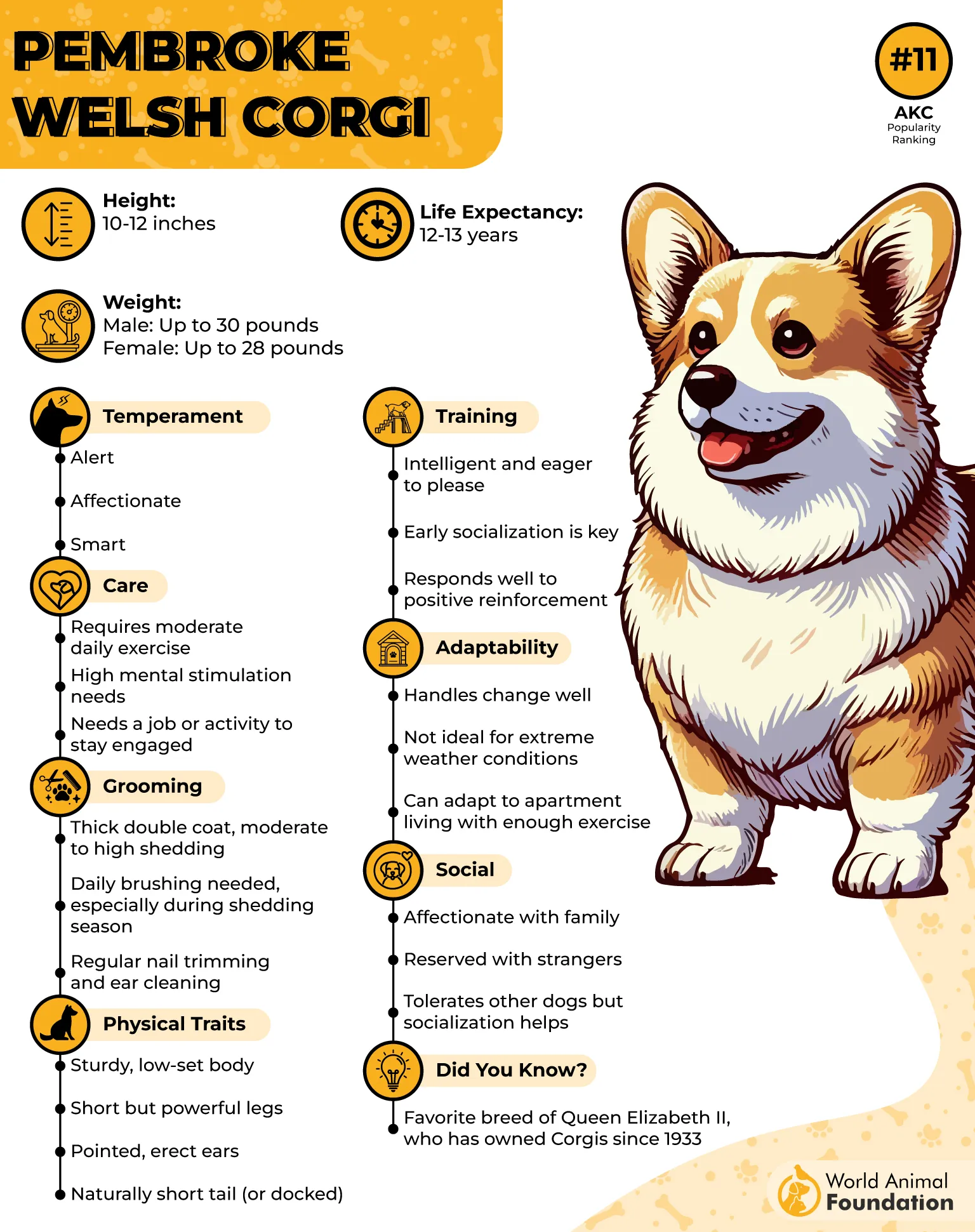
Standing around 10–12 inches tall and weighing about 30 pounds, Pembrokes pack surprising strength into their low-to-the-ground frame. One of their cutest quirks? Their tail—or lack of it! Some are born with a naturally short nub, while others have docked tails (still standard in some countries, though now restricted in many).
Quick side note: There are two Corgi types—Pembroke and Cardigan. Cardigan Welsh corgi are a tad larger, have full, fox-like tails, and a slightly different vibe. Pembrokes? They’re the no-tail dynamos you’re most likely to see herding your heart.
Corgis are clever, hilariously opinionated, and have an affectionate nature. They adore being part of the action, whether it’s herding sheep or just herding their humans from room to room. That herding instinct can show up in nippy heel-taps, so early obedience training and socialization are key to keeping their bossy streak in check.
7. Maremma Sheepdog
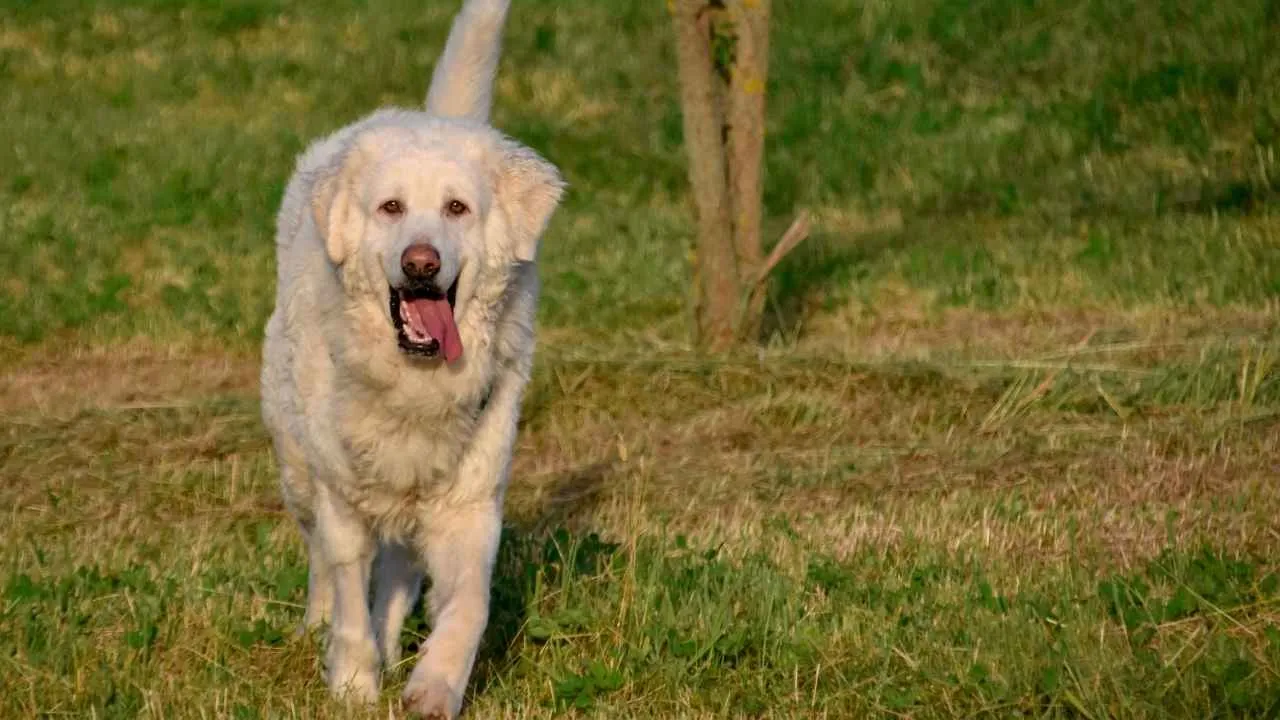
The Maremma Sheepdog—also known as the Maremmano or Cane da Pastore Abruzzese—is Italy’s majestic, cloud-like guardian. Bred as a flock guardian from wolves in the rugged hills of Abruzzo and the Maremma lowlands, this noble pup is all about loyalty, independence, and quiet strength.
With a thick white coat and sharp instincts, the Maremma is a close cousin of the Great Pyrenees. They’re smart, but don’t expect them to jump through hoops—these dogs think for themselves. That said, with positive training and clear guidance, they form rock-solid bonds and become fiercely devoted, exceptional companions.
Purina states that despite their size and guarding roots, Maremmas have a surprisingly gentle and calm demeanor. They won’t shower you with kisses, but their love shows up in quiet ways—like a soft lean or a paw on your leg. Just be ready for their watchdog instincts to kick in around strangers. That deep bark means business, and they’ll always keep a watchful eye, especially when kids are involved.
Training a Maremma takes time and patience. Start training early, use treats and praise, and keep sessions short but consistent. Their natural smarts shine with the right motivation, and some even enjoy basic agility or obedience work (on their terms, of course).
Maremmas aren’t for first-time dog parents, but for those who appreciate a quiet, watchful, and dignified dog, they’re an unforgettable match. Treat them with respect, and they’ll return it tenfold—with calm devotion and a heart of gold.
Conclusion
Herding dog breeds like the German Shepherd, Polish Lowland Sheepdog, Shetland Sheepdog, Australian Shepherd, and Entlebucher Mountain Dog are versatile dogs with a natural ability to protect livestock and thrive alongside human companions.
From the gorgeous shaggy coat of the Bearded Collie and English Sheepdog to the agile Belgian Malinois and the ancient Canaan Dog, these working dogs have been guarding farms and guiding paw prints for more than a century. Whether it’s the laughing dog charm of the Icelandic Sheepdog, the national dog status of some breeds, or the biggest French sheepdog, each breed brings unique traits like hind double dewclaws.
These excellent companions aren’t just about work—they’re about living animals forward, blending protection, play, and loyalty, proving they’re much more than just pets. So, whether you want to stop barking with your current dog or explore other breeds, these herding dogs are sure to enrich your family and life.


